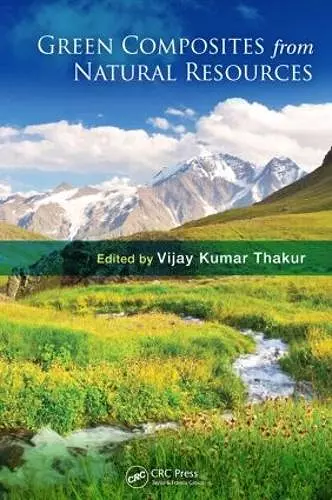Green Composites from Natural Resources
Format:Hardback
Publisher:Taylor & Francis Inc
Published:25th Nov '13
Currently unavailable, and unfortunately no date known when it will be back
This hardback is available in another edition too:
- Paperback£96.99(9781138077294)

Global awareness of environmental issues has resulted in the emergence of economically and environmentally friendly bio-based materials free from the traditional side effects of synthetics. This book delivers an overview of the advancements made in the development of natural biorenewable resources-based materials, including processing methods and potential applications in green composites. Biorenewable polymers are a special class of natural material found in nature, such as natural fibers, wheat straw, rice husk, and saw dust. In addition to offering renewable feedstocks, natural biorenewable materials are compostable, recyclable, edible, and more energy efficient to process than plastic.
Green Composites from Natural Resources covers various kinds of cellulosic biofibers, such as:
- hemp fibers
- jute
- saccaharum cilliare fibers
- pine needles
- grewia optiva fibers
- sisal fibers
- eulaliopsis binata
- flax fibers
- coconut fibers
- eulaliopsis binata
- baggase fibers
- rice husk
- saw dust
- wood flour
- straw
With scopes for the utilization of natural resources-based materials as potential replacements for traditional petroleum feedstocks on the rise, more scientists and researchers are exploring new composite materials based on biorenewable resources. This book provides information on more eco-friendly and sustainable alternatives to synthetic polymers and discusses the present state and growing utility of green materials from natural resources.
"This state-of the-art reference introduces the reader to the field of green composites. It covers different types of cellulosic fibers used to produce these materials and issues related to the structure-processing-properties relationship and also its life cycle assessment. Containing the latest developments in the area of green composites this book will become an important reference for any course in the field of cellulosic materials or composites."
–João Paulo Miranda Ribeiro Borges, Universidade Nova de Lisboa, Portugal
"The book has a wide range of information, due to its specific subjects from green composites domains, as well as its multidisciplinary content, being useful in various fields of study and applicability. … Each chapter is written with teaching skills, and contains recent scientific information. Thus, the book will contribute significantly to the knowledge base of students and researchers working in the field of green materials, including physicists, chemists, engineers, bio-engineers, or biologists."
––Silvia Ioan, Petru Poni Institute of Macromolecular Chemistry, Iasi, Romania
"The book covers a wide range of issues related to green composites. It is an updated and useful source of reliable information on this exciting subject. It [also provides] information on the most important renewable fibre sources, which [makes it] a very precious book."
—Cláudio Del Menezzi, University of Brasília, Brazil
"I will definitely have it on my shelf because it covers a wide scope of biopolymer materials. … The book is relevant to the current research disciplines and it will extensively contribute to the scientific or engineering fields."
—Dr. Caroline Khoathane, Tshwane University of Technology, Pretoria, South Africa
"…the ultimate goal of biopolymer-based materials research can be considered as promising future material to reduce the burning of fossil fuels. The growing use of biomass for energy would play a vital role in managing with greenhouse warming than is possible with the mounting of trees solely for carbon sequestration. Therefore, this book Green Composites from Natural Resources provides a certain platform to understand much about new micro/nano composite materials based on biopolymers and their applications including automotive, paper making, building materials, toxic ion removal, etc."
—Prof. Tarun K.Maji, Tezpur University, Assam, India
"It provides an insight on recent reports and progress made in the development of natural polymers/renewable materials for their vast applications. The material also provides information on how the environmental footprints can be reduced in our daily life. It’s comprehensive … very well focused, but covers an entire range of natural products."
—Dr. Dilip Depan, University of Louisiana at Lafayette, USA
"This book … provides a good overview of green composites not only for beginners or engineering students, but also for specialists of an area who would like to know more … I could certainly use this book to learn about subjects such as life cycle assessment or fibre chemical treatments. More generally, the book could certainly help any researcher in the green area field to increase their general knowledge."
—Pierre Ouagne, University of Orleans, France
"Approach and selection of topics is good … This book will help post-graduate students [and] research scholars who are working in the area of green composites."
—K. Ramanaiah, Velagapudi Ramakrishna Siddhartha Engineering College, Vijayawada, India
"This book presents new insight in biocomposites by looking at non-conventional aspects of the research, such as structural application of biocomposites, biomedical application of biocomposites, life cycle assessment of biocomposites, machining of biocomposites, and vegetable oils for composites."
—Professor Mohd Sapuan Salit, Universiti Putra Malaysia, Surdang
"As oil is depleting and environmental concern is globally rising, developing materials and composites with the desired properties from lignocelluloses and green materials is [on] topic today. This book covers different aspects of this topic from the ground until the applications in different fields."
—Professor Mohammad Taherzadeh, University of Borås, Sweden
ISBN: 9781466570696
Dimensions: unknown
Weight: 725g
419 pages